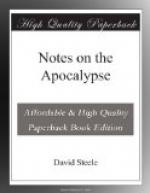21. The grace of our Lord Jesus Christ be with you all. Amen.
V. 21.—These are also the words of John. He had just been addressing the “Lord Jesus,” and his next words are addressed to the “seven churches,” (ch. i. 4, 11,) or to all who read or hear the words of this book: but especially the church general. This is a concise form of the “apostolic benediction,” (2 Thess. iii. 18,) which is sometimes amplified, by naming the Father and the Son; or, at other times, the three divine persons. (2 Cor. xiii. 14.) However, “the grace of the Lord Jesus Christ” is originally from God the Father, procured for us by Jesus Christ, and communicated to us by the Holy Spirit. And unto the Father, the Son, and the Holy Ghost, let equal, undivided, and everlasting glory be ascribed, by all the subjects of his regenerating and sanctifying grace, “throughout all ages, world without end.” Amen.
FOOTNOTES:
[Footnote 1: Life of Martin Luther. Pp. 173, 174. London. 1855. Luther afterwards became convinced of his error.]
[Footnote 2: Gibbon has unconsciously written a commentary on prophecy!—an involuntary witness, like Josephus!]
[Footnote 3: “It has been our lot to hear the voice of the third woe,” Faber.—“In this I entirely agree with that expositor.” M’Leod. The blinding influence of earth’s politics upon the minds of pious men, has often occasioned the hearts of their brethren to “sigh for their inconsistency.”]
[Footnote 4: The terms “clergy and laity” are of papal origin, and the unlearned Christian should know that they are contrary to the mind of the Holy Spirit. 1 Pet. v. 3. The body of the people are “God’s heritage,”—clergy.]
[Footnote 5: Gibbon.]
[Footnote 6: Mosheim.]
[Footnote 7: Such is the interpretation of Bishop Newton!]
[Footnote 8: Faber.]
[Footnote 9: This is the opinion of Mr. Faber.]
[Footnote 10: Scott.]
[Footnote 11: Scott]
[Footnote 12: So Mr. Faber imagined.]
[Footnote 13: So designated by Nicholas, late emperor of Russia.]
APPENDIX.
THE NEW JERUSALEM.
Interpreters are much divided in opinion as to the import of this symbol. Some think it represents the church on earth during the period of the millennium; while others, no less learned and pious, consider it as an emblematical representation of the heavenly state. Of those who acquiesce in the former view, some consider the arguments “quite conclusive.” It may be conceded that much may be advanced, and with great plausibility, in support of this position.




